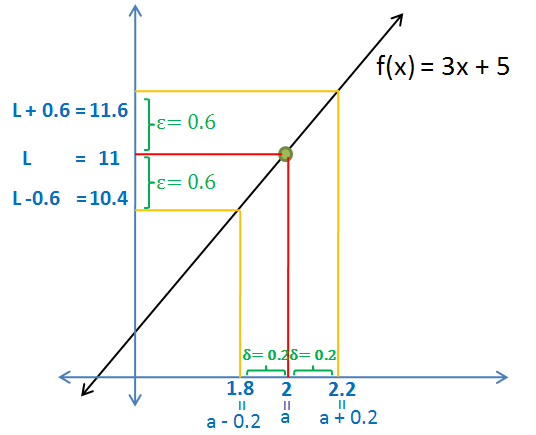Limit by epsilon-delta proof: Example 1
We have discussed extensively the meaning of the definition. In this post, we are going to learn some strategies to prove limits of functions by definition. The meat of the proof is finding a suitable
for all possible
values.
Recall that the definition states that the limit of as
approaches
, if for all
, however small, there exists a
such that if
, then
.
Example 1: Let . Prove that
If we are going to study definition limit above, and apply it to the given function, we have , if for all
, however small, there exists a
such that if
, then
. We want to find the value of
, in terms of
; therefore, we can manipulate one of the inequalities to the other’s form. In particular, we will manipulate
to an expression such that the expression inside the absolute value sign will become
.

Simplifying, we have . This expression is equivalent to
. Dividing both sides by
, we have
. Now, both inequalities have the same form.

That means that whatever value of is, we can find a
satisfying the conditions above. To explain further, let us have a specific example.
Let us choose a small . From the definition, for
, there exists a
such that if
, then
. The geometric interpretation of this statement is shown below.
Now, let us intepret the definition. While reading these statements, look at the third diagram above:
- Our
, we have chosen
, and our computation gives us
.
- The statement, let
means that we are creating an interval which is
. This can be seen in the y-axis.
- The statement
means that we are creating an interval
. This can be seen in the x-axis
- In layman’s term, for
, there exists a
such that if we take the value a particular
between
and
, we are sure that the corresponding
is between
and
. Recall, however, that
is a particular value. The definition states that we can make it as small as we want and still find a suitable
, however small, our
is.
- In fact a game can be developed where player A gives a particular
, and player B searches for a suitable
satisfying the definition. No matter small a value player A assigns to
, we are sure that player B can always find a suitable
satisfying the definition.
The general strategy in proving limits by definition is to manipulate the inequality
such that the expression
is simplified to
.
To explain the definition of limits further, I will give you three or four more examples in the near future.
